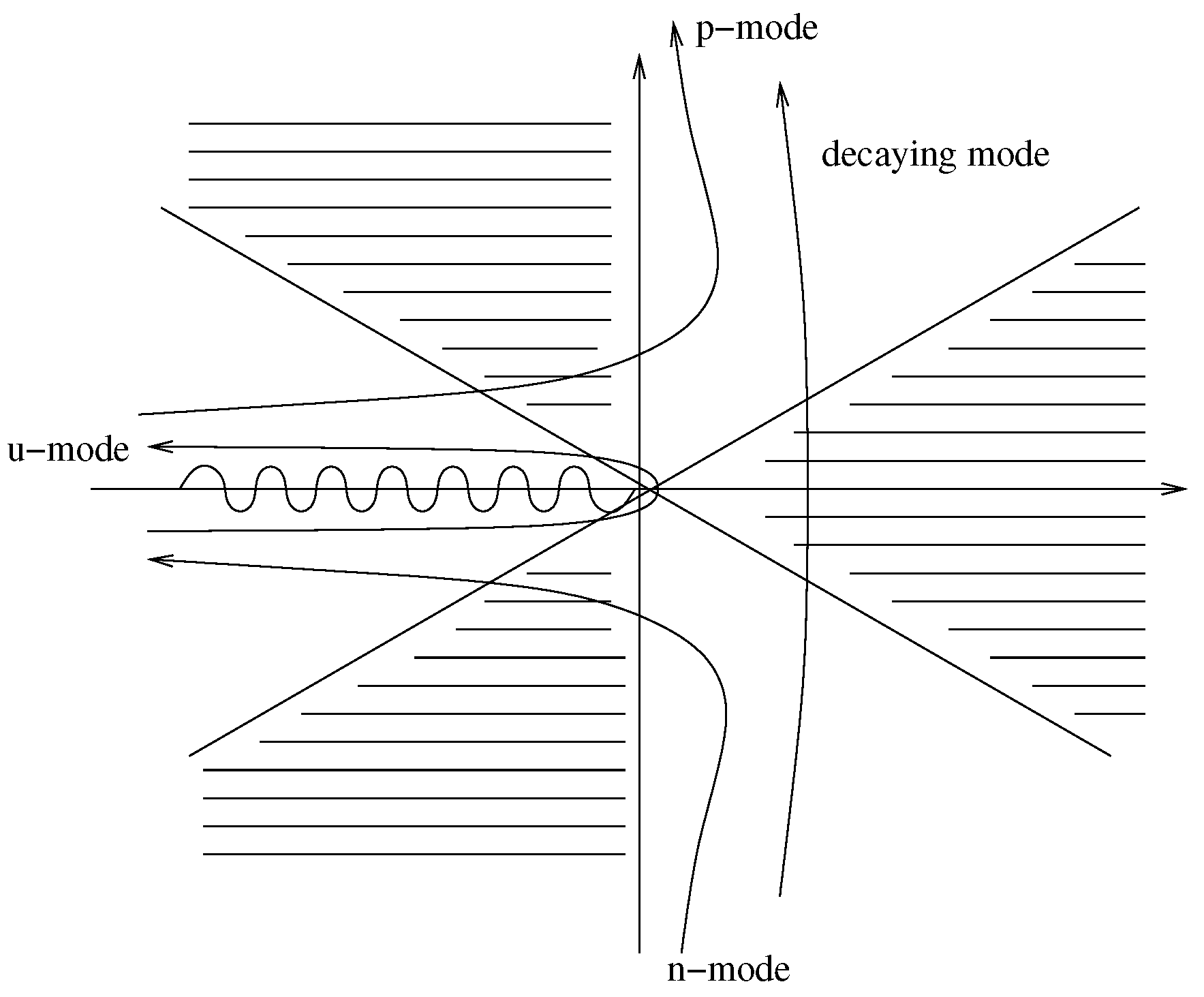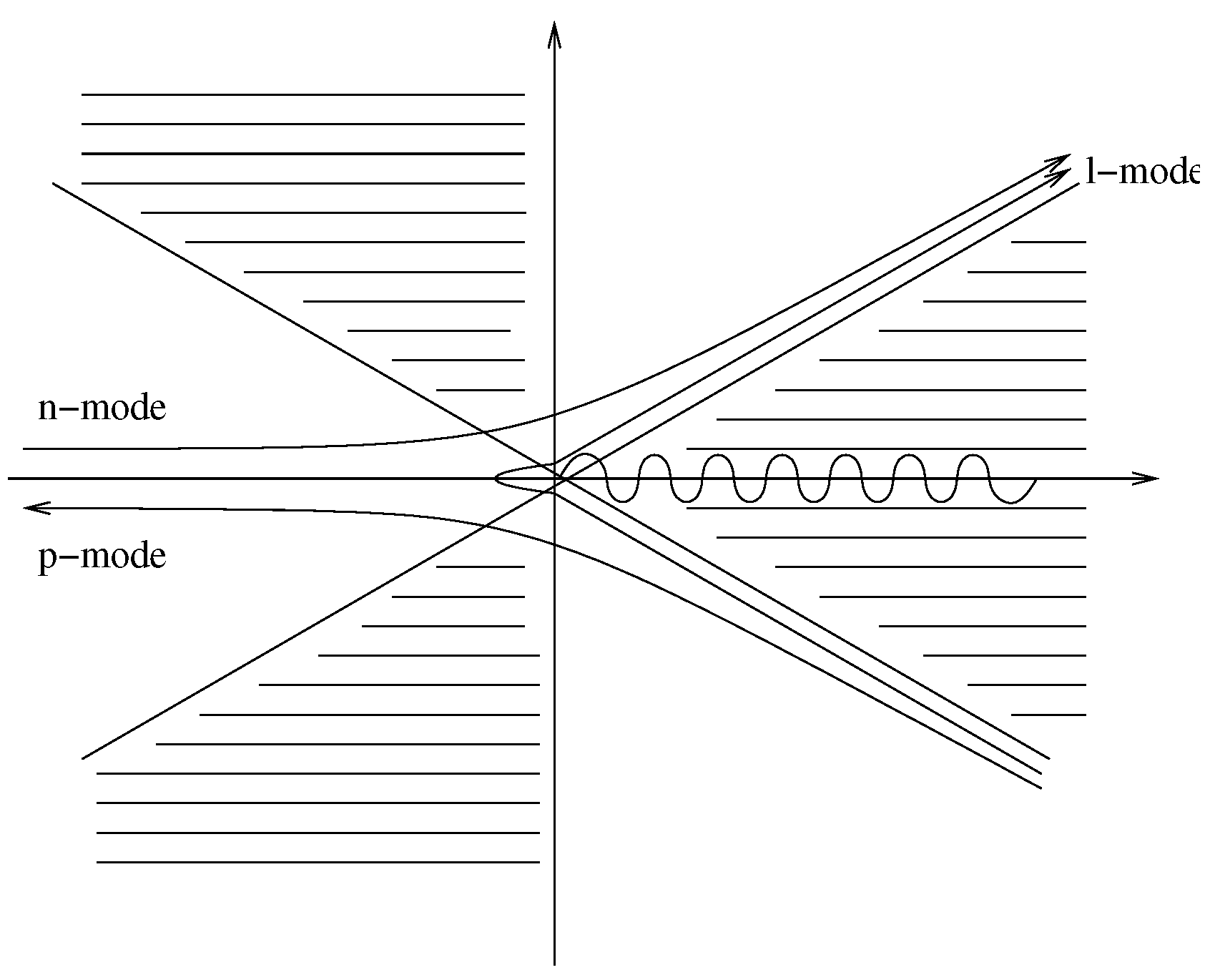Analogous Hawking Effect: S-Matrix and Thermofield Dynamics
Abstract
:1. Introduction
2. The Master Equation: An Orr–Sommerfeld Type Fourth-Order Equation
3. The -Matrix in Presence of Dispersion
3.1. The Complete S-Matrix
3.2. The Hawking Partner
3.3. Generalized Hawking Effect in Analogue Gravity
3.4. The Third Process
3.5. The S-Matrix
3.6. A Perturbative Approach to the S-Matrix
3.7. A General Parametrization of the S-Matrix
4. Thermofield Dynamics and Thermality
4.1. A Summary of TFD
4.2. Analogue Hawking Effect and TFD
5. Conclusions
Author Contributions
Funding
Data Availability Statement
Conflicts of Interest
References
- Belgiorno, F.; Cacciatori, S.L.; Viganò, A. Analog Hawking effect: A master equation. Phys. Rev. D 2020, 102, 105003. [Google Scholar] [CrossRef]
- Belgiorno, F.; Cacciatori, S.L.; Farahat, A.; Viganò, A. Analog Hawking effect: BEC and surface waves. Phys. Rev. D 2020, 102, 105004. [Google Scholar] [CrossRef]
- Larre, P.E.; Recati, A.; Carusotto, I.; Pavloff, N. Quantum fluctuations around black hole horizons in Bose-Einstein condensates. Phys. Rev. A 2012, 85, 013621. [Google Scholar] [CrossRef] [Green Version]
- Coutant, A.; Parentani, R.; Finazzi, S. Black hole radiation with short distance dispersion, an analytical S-matrix approach. Phys. Rev. D 2012, 85, 024021. [Google Scholar] [CrossRef] [Green Version]
- Coutant, A.; Parentani, R. Hawking radiation with dispersion: The broadened horizon paradigm. Phys. Rev. D 2014, 90, 121501. [Google Scholar] [CrossRef] [Green Version]
- Coutant, A.; Weinfurtner, S. Low-frequency analogue Hawking radiation: The Korteweg-de Vries model. Phys. Rev. D 2018, 97, 025005. [Google Scholar] [CrossRef] [Green Version]
- Coutant, A.; Weinfurtner, S. Low frequency analogue Hawking radiation: The Bogoliubov-de Gennes model. Phys. Rev. D 2018, 97, 025006. [Google Scholar] [CrossRef] [Green Version]
- Corley, S. Computing the spectrum of black hole radiation in the presence of high frequency dispersion: An analytical approach. Phys. Rev. D 1998, 57, 6280–6291. [Google Scholar] [CrossRef] [Green Version]
- Israel, W. Thermo field dynamics of black holes. Phys. Lett. A 1976, 57, 107–110. [Google Scholar] [CrossRef]
- Drori, J.; Rosenberg, Y.; Bermudez, D.; Silberberg, Y.; Leonhardt, U. Observation of Stimulated Hawking Radiation in an Optical Analogue. Phys. Rev. Lett. 2019, 122, 010404. [Google Scholar] [CrossRef] [PubMed] [Green Version]
- Nishimoto, T. On the Orr-Sommerfeld type equations. II. Connection formulas. Kŏdai Math. Sem. Rep. 1978, 29, 233–249. [Google Scholar] [CrossRef]
- Belgiorno, F.; Cacciatori, S.L. Analogous Hawking Effect in Dielectric Media and Solitonic Solutions. Universe 2020, 6, 127. [Google Scholar] [CrossRef]
- Unruh, W.G.; Schützhold, R. Universality of the Hawking effect. Phys. Rev. D 2005, 71, 024028. [Google Scholar] [CrossRef] [Green Version]
- Linder, M.F.; Schutzhold, R.; Unruh, W.G. Derivation of Hawking radiation in dispersive dielectric media. Phys. Rev. D 2016, 93, 104010. [Google Scholar] [CrossRef] [Green Version]
- Belgiorno, F.; Cacciatori, S.L.; Piazza, F.D.; Doronzo, M. Hopfield-Kerr model and analogue black hole radiation in dielectrics. Phys. Rev. D 2017, 96, 096024. [Google Scholar] [CrossRef] [Green Version]
- Wald, R.M. Particle creation by black holes. Commun. Math. Phys. 1975, 43, 199–220. [Google Scholar] [CrossRef]
- Ruijsenaars, S.N.M. On Bogoliubov transformations. II. The general case. Annals Phys. 1978, 116, 105–134. [Google Scholar] [CrossRef]
- Wald, R.M. Existence of the S-matrix in quantum field theory in curved space-time. Annals Phys. 1979, 118, 490–510. [Google Scholar] [CrossRef]
- Fulling, S.A. Aspects of Quantum Field Theory in Curved Spacetime; Cambridge University Press: Cambridge, MA, USA, 1989. [Google Scholar]
- Kato, T. Perturbation Theory for Linear Operators; Springer: Berlin, Germany, 1980. [Google Scholar]
- Vinish, Y.; Fleurov, V. Finite width of the optical event horizon and enhancement of analog Hawking radiation. Int. J. Mod. Phys. B 2016, 30, 1650197. [Google Scholar] [CrossRef] [Green Version]
- Iwasawa, K. On Some Types of Topological Groups. Ann. Math. 1949, 50, 507–558. [Google Scholar] [CrossRef]
- Cacciatori, S.L.; Cerchiai, B.L. Exceptional Groups, Symmetric Spaces and Applications. In Group Theory: Classes, Representation and Connections, and Applications; Danellis, C.W., Ed.; Nova Publishers: New York, NY, USA, 2010. [Google Scholar]
- Matsumoto, H.; Umezawa, H.; Tachiki, M. Thermo Field Dynamics and Condensed States; North-Holland Publishing Company: Amsterdam, The Netherlands, 1982. [Google Scholar]
- Das, A. Finite Temperature Field Theory; World Scientific: Singapore, 1997. [Google Scholar]
- Umezawa, H. Advanced Field Theory: Micro, Macro, and Thermal Physics; American Institute of Physics Press: Woodbury, NY, USA, 1995. [Google Scholar]
- Khanna, F.C.; Malbouisson, A.P.C.; Malbouisson, J.M.C.; Santana, A.E. Thermal Quantum Field Theory; World Scientific Publishing Company: Singapore, 2009. [Google Scholar]
- Jacobson, T. Black holes and Hawking radiation in spacetime and its analogues. In Analogue Gravity Phenomenology; Faccio, D., Belgiorno, F., Cacciatori, S., Gorini, V., Liberati, S., Moschella, U., Eds.; Springer: Berlin, Germany, 2013; pp. 1–29. [Google Scholar]
- Belgiorno, F.D.; Cacciatori, S.L.; Faccio, D. Hawking Radiation: From Astrophysical Black Holes to Analogous Systems in Lab; World Scientific Publishing Company: Singapore, 2018; ISBN 9789814508537. [Google Scholar]



Publisher’s Note: MDPI stays neutral with regard to jurisdictional claims in published maps and institutional affiliations. |
© 2022 by the authors. Licensee MDPI, Basel, Switzerland. This article is an open access article distributed under the terms and conditions of the Creative Commons Attribution (CC BY) license (https://creativecommons.org/licenses/by/4.0/).
Share and Cite
Belgiorno, F.; Cacciatori, S.L. Analogous Hawking Effect: S-Matrix and Thermofield Dynamics. Universe 2022, 8, 105. https://doi.org/10.3390/universe8020105
Belgiorno F, Cacciatori SL. Analogous Hawking Effect: S-Matrix and Thermofield Dynamics. Universe. 2022; 8(2):105. https://doi.org/10.3390/universe8020105
Chicago/Turabian StyleBelgiorno, Francesco, and Sergio L. Cacciatori. 2022. "Analogous Hawking Effect: S-Matrix and Thermofield Dynamics" Universe 8, no. 2: 105. https://doi.org/10.3390/universe8020105
APA StyleBelgiorno, F., & Cacciatori, S. L. (2022). Analogous Hawking Effect: S-Matrix and Thermofield Dynamics. Universe, 8(2), 105. https://doi.org/10.3390/universe8020105






